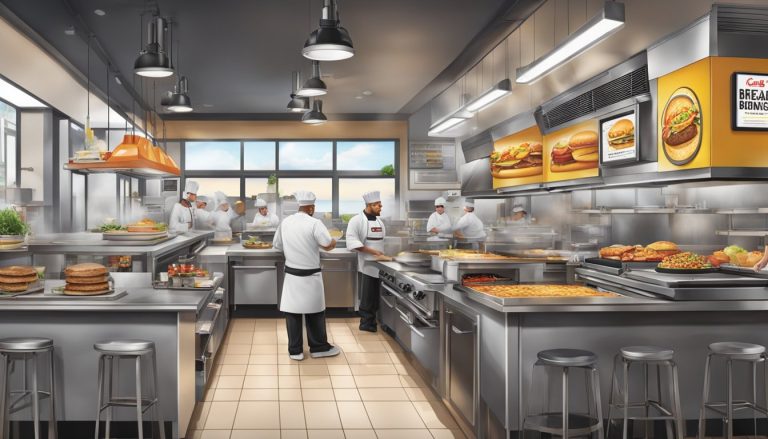Carl’s Jr. has been a major player in the fast food industry since its founding in 1941. Over the decades, the chain has continually innovated its menu offerings, including its popular breakfast options. Carl’s Jr.’s breakfast menu has evolved from simple staples to a diverse array of hearty and indulgent morning meals, reflecting changing consumer tastes and dietary trends.
The breakfast menu at Carl’s Jr. now features a wide variety of options to suit different preferences. Customers can choose from savory biscuit sandwiches, breakfast burritos, and traditional egg platters. The chain has also adapted to health-conscious consumers by introducing lighter fare and using higher-quality ingredients in some of its offerings.
As part of CKE Restaurants Holdings, Carl’s Jr. has leveraged its position to stay competitive in the fast food breakfast market. The company’s willingness to experiment with new flavors and menu items has helped it maintain relevance in a crowded field. From classic breakfast sandwiches to more innovative creations, Carl’s Jr.’s breakfast menu continues to evolve to meet the demands of modern consumers.
Foundations of Carl’s Jr. Breakfast

Carl’s Jr. breakfast offerings evolved from simple beginnings to become a significant part of the restaurant’s menu. The expansion of breakfast items reflected changing consumer tastes and the company’s growth strategy.
The Origins of Carl’s Jr. Breakfast Options
Carl’s Jr. introduced breakfast items in the 1970s to capture the morning market. The initial menu featured basic options like egg sandwiches and coffee.
As customer demand grew, Carl’s Jr. expanded its breakfast selections. They added Hash Rounds, a crispy potato side dish, which became a popular accompaniment to breakfast sandwiches.
In the 1980s, Carl’s Jr. began experimenting with more diverse breakfast options. They introduced biscuit sandwiches and breakfast burritos to cater to different regional tastes.
CKE Restaurants and Franchise Evolution
CKE Restaurants, Carl’s Jr.’s parent company, played a crucial role in shaping the breakfast menu. The company’s acquisition of Hardee’s in 1997 influenced Carl’s Jr.’s breakfast offerings.
CKE Restaurants leveraged Hardee’s successful breakfast items, particularly their biscuits. In 2011, Carl’s Jr. introduced Hardee’s-style biscuits in select Southern California locations.
This move aimed to boost Carl’s Jr.’s breakfast sales, which lagged behind Hardee’s at the time. The integration of Hardee’s breakfast items marked a significant shift in Carl’s Jr.’s morning menu strategy.
Franchisees played a key role in refining breakfast options to suit local tastes. This flexibility allowed Carl’s Jr. to adapt its breakfast menu across different regions.
Expanding the Breakfast Menu
Carl’s Jr. has continuously evolved its breakfast offerings to meet changing consumer tastes and preferences. The chain introduced iconic items, expanded regional flavors, and incorporated plant-based alternatives to broaden its appeal.
Introduction of Iconic Breakfast Items
Carl’s Jr. made waves with the debut of its Monster Biscuit in 2004. This hearty sandwich featured two eggs, bacon, sausage, and cheese on a buttery biscuit. It quickly became a fan favorite.
The Breakfast Burger, launched in 2004, blurred the lines between breakfast and lunch. It combined a beef patty with egg, bacon, and hash browns on a bun.
In 2017, Carl’s Jr. made the Breakfast Burger available all day, catering to customers craving breakfast flavors beyond morning hours.
Breakfast Burritos and Regional Flavors
Carl’s Jr. embraced the breakfast burrito trend in the late 1990s. The chain introduced several varieties to appeal to diverse taste preferences.
The Loaded Breakfast Burrito became a menu staple, packed with sausage, bacon, eggs, Hash Rounds, and cheese. It offered a satisfying start to the day at 760 calories.
Carl’s Jr. also introduced regional flavors in some markets. In the Southwest, green chile-infused burritos gained popularity.
Incorporation of Beyond Meat and Alternatives
Responding to growing demand for plant-based options, Carl’s Jr. partnered with Beyond Meat in 2018. This collaboration led to the introduction of the Beyond Breakfast Sausage Burrito in 2020.
The Beyond Breakfast Sausage Burrito features plant-based sausage, eggs, cheese, and Hash Rounds. It caters to flexitarians and those seeking meat alternatives.
Carl’s Jr. continues to explore vegetarian-friendly breakfast items, aiming to attract health-conscious consumers without sacrificing flavor.
Notable Breakfast Items Over Time

Carl’s Jr. has introduced numerous iconic breakfast items over the years, ranging from hearty sandwiches to innovative burritos and sweet treats. These offerings have evolved to meet changing consumer tastes while maintaining the brand’s signature indulgent style.
Signature Breakfast Sandwiches
The Breakfast Burger stands out as a Carl’s Jr. breakfast menu staple. Introduced in 2004, it combines a charbroiled all-beef patty with egg, bacon, and cheese on a seeded bun. This unique fusion of breakfast and lunch flavors proved popular enough to become available all day in 2017.
Another notable sandwich is the Grilled Cheese Breakfast Sandwich. It features folded eggs and bacon between two slices of grilled sourdough bread with melted American cheese. This item appeals to those seeking a comforting, familiar breakfast option with a Carl’s Jr. twist.
Innovative Burritos and More
Carl’s Jr. has embraced the breakfast burrito trend with several creative options. The Steak and Egg Burrito combines seasoned steak strips with scrambled eggs, cheese, and salsa in a warm tortilla. It offers a protein-packed start to the day for hungry customers.
The Loaded Breakfast Burrito takes things further by adding hash browns and sausage to the mix. This hearty option caters to those looking for a substantial morning meal that can keep them satisfied until lunch.
French Toast Dips represent a unique offering in the fast-food breakfast space. These portable, dippable French toast sticks come with a side of syrup, allowing customers to enjoy a traditionally sit-down breakfast on the go.
Savory and Sweet Selections
Carl’s Jr. balances its menu with both savory and sweet options. On the savory side, biscuit sandwiches featuring eggs, cheese, and various meats have been menu mainstays. These provide a Southern-inspired breakfast option for those craving something hearty.
For those with a sweet tooth, the Cinnamon Roll has been a popular choice. This warm, gooey pastry offers a decadent start to the day or a mid-morning treat. Its sweet aroma and rich flavor make it a standout item on the breakfast menu.
Side items like hash rounds (Carl’s Jr.’s version of hash browns) complement the main breakfast offerings, allowing customers to build their ideal morning meal.
Guest Experience Enhancements
Carl’s Jr. has implemented key changes to improve customer satisfaction and convenience. These initiatives have focused on expanding breakfast availability and offering more flexible dining options.
Extension of Breakfast Hours
Carl’s Jr. extended its breakfast hours to cater to late risers and shift workers. The chain now serves breakfast until 10:30 AM at most locations, allowing customers more time to enjoy their morning favorites. This change has been particularly popular among college students and young professionals.
The extended hours also include an expanded menu featuring items like the Breakfast Burger Combo. This unique offering combines traditional breakfast elements with the chain’s signature burgers, appealing to those craving a heartier morning meal.
Introduction of All-Day Breakfast
Following the lead of other fast food chains, Carl’s Jr. introduced all-day breakfast at select locations. This move allows customers to order popular breakfast items throughout the day, catering to various schedules and cravings.
The all-day breakfast menu includes staples like biscuits, breakfast sandwiches, and hash rounds. This flexibility has proven popular with customers who enjoy breakfast foods outside traditional morning hours. It has also given Carl’s Jr. a competitive edge in the fast food market, attracting customers seeking breakfast options later in the day.
Impact on Industry and Culture

Carl’s Jr.’s breakfast menu innovations have influenced fast food trends and expanded the chain’s global reach. The company’s bold breakfast offerings have set new standards and attracted customers in diverse markets.
Comparison With Other Fast Food Breakfasts
Carl’s Jr. distinguishes itself with unique menu items like the Breakfast Burger and Grilled Cheese Breakfast Sandwich. These offerings combine classic breakfast flavors with bold twists, setting the chain apart from competitors.
The Breakfast Burger, introduced in 2004, features a beef patty topped with egg, bacon, and cheese. This concept has inspired similar items at other fast food chains.
Carl’s Jr.’s breakfast menu emphasizes quality ingredients and generous portions. The chain uses fresh-cracked eggs and hand-breaded chicken in many breakfast items, appealing to customers seeking higher-quality fast food options.
Carl’s Jr. in International Markets
Carl’s Jr. has successfully adapted its breakfast menu for international tastes. The chain operates in over 40 countries, tailoring offerings to local preferences while maintaining its core identity.
In Mexico, Carl’s Jr. offers breakfast burritos with regional ingredients. Asian markets feature rice-based breakfast bowls alongside American-style options.
The brand’s willingness to experiment with flavors has helped it gain traction in diverse culinary landscapes. Carl’s Jr.’s breakfast menu serves as a bridge between American fast food culture and international tastes.
This adaptability has contributed to the chain’s global expansion and popularity in markets where American-style breakfasts are less common.
Additional Menu Innovations

Carl’s Jr. has consistently introduced new menu items to keep customers excited. The Western Bacon Cheeseburger, launched in the 1980s, became an instant classic with its tangy BBQ sauce and crispy onion rings.
In the 2000s, Carl’s Jr. debuted Hand-Breaded Chicken Tenders, offering a premium alternative to traditional fast food chicken options. These tenders quickly gained popularity for their crispy texture and high-quality meat.
The Thickburger line, introduced in 2003, elevated Carl’s Jr.’s burger offerings. These 1/3 and 1/2 pound Angus beef patties provided a more substantial option for hungry customers.
Breakfast innovations continued with the Bacon, Egg and Cheese Burrito. This handheld item combined classic breakfast flavors in a convenient format for on-the-go diners.
Carl’s Jr. expanded its chicken menu with various Chicken Sandwiches, catering to different tastes and preferences. Options ranged from grilled to crispy, with various toppings and sauces.
The Big Carl, launched in 2009, offered a double-patty burger with Carl’s Jr.’s signature sauce. This item aimed to compete with similar offerings from other fast food chains.
These menu additions demonstrate Carl’s Jr.’s commitment to culinary innovation and meeting changing consumer preferences over the decades.
Menu Diversification

Carl’s Jr. expanded its offerings beyond breakfast to cater to a wider range of customer preferences throughout the day. The chain introduced diverse options to complement its core menu items and appeal to health-conscious consumers.
Beyond Breakfast: Lunch and Dinner Options
Carl’s Jr. developed a robust selection of burgers, sandwiches, and other entrees for lunch and dinner. The chain focused on bold flavors and generous portions, targeting young males aged 18-34. Premium ingredients and unique toppings became hallmarks of their burger lineup. Charbroiled all-beef patties formed the foundation of many menu items. The brand also introduced turkey burgers in 2011, becoming the first national chain to do so.
Carl’s Jr. continued to innovate with new sandwich options and protein choices. This diversification allowed the restaurant to compete more effectively in the fast-food market beyond the breakfast hours.
Salads, Sides, and Desserts
In 1977, Carl’s Jr. became a pioneer in fast-food salad offerings by installing self-serve salad bars in all 200 of its California locations. This move predated similar initiatives by competitors and helped spark the salad bar trend of the 1980s. The chain later transitioned to pre-made salads for convenience and food safety.
French fries remained a popular side, but Carl’s Jr. also introduced alternatives like:
- Hash Rounds (crispy potato bites)
- Onion rings
- Fried zucchini
For those with a sweet tooth, milkshakes became a staple dessert option. The chain offered classic flavors alongside limited-time seasonal variations. Other dessert items included hand-scooped ice cream and cookies, providing indulgent options to round out meals.




